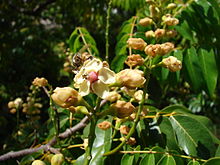| Cóbana negra | |
|---|---|

| |
| Conservation status | |
 Endangered (IUCN 2.3) | |
 Threatened (ESA) | |
| Scientific classification | |
| Kingdom: | Plantae |
| Clade: | Tracheophytes |
| Clade: | Angiosperms |
| Clade: | Eudicots |
| Clade: | Rosids |
| Order: | Fabales |
| Family: | Fabaceae |
| Subfamily: | Caesalpinioideae |
| Genus: | Libidibia |
| Species: | L. monosperma |
| Binomial name | |
| Libidibia monosperma (Tul.) E. Gagnon & G. P. Lewis | |
| Synonyms | |
| |
Libidibia monosperma is a species of legume in the family Fabaceae, with the common names cóbana negra and cóbana polisandro. It is found in the Dominican Republic, Puerto Rico, and the United States Virgin Islands. It is a federally listed threatened species of the United States.
References
- World Conservation Monitoring Centre (1998). "Stahlia monosperma". IUCN Red List of Threatened Species. 1998: e.T30963A9584227. doi:10.2305/IUCN.UK.1998.RLTS.T30963A9584227.en. Retrieved 26 December 2023.
- ^ "Cobana negra (Stahlia monosperma)". Environmental Conservation Online System. U.S. Fish & Wildlife Service. Retrieved 26 December 2023.
- ^ 55 FR 12790
- Gagnon E, Bruneau A, Hughes CE, de Queiroz LP, Lewis GP (2016). "A new generic system for the pantropical Caesalpinia group (Leguminosae)". PhytoKeys (71): 1–160. doi:10.3897/phytokeys.71.9203. PMC 5558824. PMID 28814915.
- "Vieques National Wildlife Refuge Comprehensive Conservation Plan and Environmental Impact Statement" (PDF). www.fws.gov/. U.S. Department of the Interior Fish and Wildlife Service Southeast Region. p. 44. Retrieved 10 April 2021.
External links
| Taxon identifiers | |
|---|---|
| Libidibia monosperma | |
| Caesalpinia monosperma | |
| Stahlia monosperma |
|
This Caesalpinioideae-related article is a stub. You can help Misplaced Pages by expanding it. |